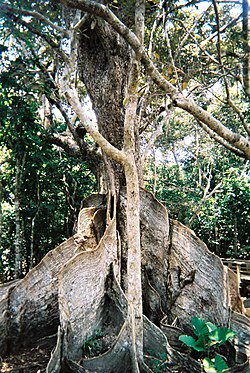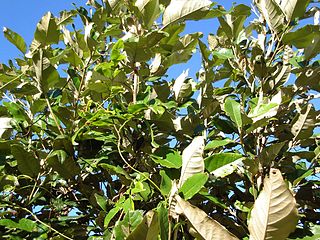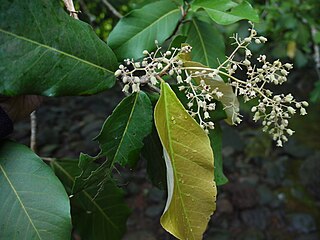Biology:Heritiera littoralis
| Looking-glass mangrove | |
|---|---|

| |
| The distinctive ribbon-like buttress roots | |
| Scientific classification | |
| Kingdom: | Plantae |
| Clade: | Tracheophytes |
| Clade: | Angiosperms |
| Clade: | Eudicots |
| Clade: | Rosids |
| Order: | Malvales |
| Family: | Malvaceae |
| Genus: | Heritiera |
| Species: | H. littoralis
|
| Binomial name | |
| Heritiera littoralis | |
| Synonyms[2] | |
| |
Heritiera littoralis, commonly known as the looking-glass mangrove or tulip mangrove, is a mangrove tree in the family Malvaceae native to coastal areas of eastern Africa, Asia, Melanesia and northern Australia . The common name refers to the silvery appearance of the underside of the leaves, resembling a mirror to some degree. The strong timber has uses in marine applications and elsewhere.
Description
Heritiera littoralis is an evergreen tree growing up to 25 m (82 ft) in height with very prominent, sinuous buttress roots that may be up to 1 m (3 ft 3 in) tall.[3][4][5] It is usually low-branching and the crown is untidy-looking with gnarled branches.[5] The trunk is light grey or grey-brown in appearance, smooth when young but developing vertical fissures as it ages.[4][5]
The leaves are spirally arranged on the branches and varyingly measure from 20 by 10 centimetres (7.9 by 3.9 in)[6][7] up to 30 by 15 centimetres (11.8 by 5.9 in),[3][5] with a petiole up to 2 cm (0.79 in) long. They are oblong-elliptical to ovate-elliptical, dark green on the upper surface and the undersides are silvery-white to light brown due to the presence of stellate scales.[3][4][7]
The inflorescences are axillary panicles, and as this species is monoecious, they bear both pistillate (functionally female) and staminate (functionally male) flowers on the same plant.[5][6] The flowers have a fused perianth tube with usually 5 teeth and are bell-shaped (hence the common name Tulip oak). They are greenish-pink or dull purple, around 6 mm (0.24 in) wide and long.[3][4][5][6]
The fruit is a flattened, ellipsoid, indehiscent, brown woody pod which is derived from the carpel, and contains a single seed. It has a distinctive oblique keel on the uppermost side and measures up to 10 cm (3.9 in) long by 6 cm (2.4 in) wide.[3] The fruit can float for several weeks and so is able to take advantage of tides, currents and winds to aid in its dispersal.[5]
Taxonomy
This species was first described by the Scottish botanist William Aiton in 1789, who at the time was the director of the botanical garden at Kew. The description was published in the third volume of his work Hortus Kewensis, in which he also raised the genus Heritiera.[8][9]
Subspecies
The Global Biodiversity Information Facility recognises two infraspecies, Heritiera littoralis subsp. littoralis, and Heritiera littoralis subsp. fischeri,[10] while Plants of the World Online does not recognise any.[2]
Etymology
The genus name Heritiera was given in honour of the France botanist Charles Louis L'Héritier de Brutelle. The species epithet litoralis means "by the sea" in reference to the habitat of this plant.[11]
Vernacular names
Regional common names for the tree include:[12][13]
Distribution and habitat
Heritiera littoralis's natural range is eastern Africa, Madagascar , India , Southeast Asia, Melanesia and the Northern Territory and Queensland in Australia.[3][6][5] It grows in the landward edges of mangrove forests and along riverine forests at elevations close to sea level.[3][5][14]
Ecology
This species is host for the larvae of a number of lepidopterans including: Arhopala micale, Arhopala pseudocentaurus, Assara seminivale, Hymenoptychis sordida and Synnympha perfrenis.[3][15]
Uses
The tree is harvested for timber and is valued for its toughness, durability, and resistance to saltwater. It is commonly used in shipbuilding and for pilings, bridges, wharves, furniture and housing. When sufficiently straight and high, the trunk has been used for ship's masts.[5][6][16]
The fruit of species in the genus is used in Philippine cuisine to neutralize the fishy taste in kinilaw, a local dish of raw fish in vinegar or citrus juices. Another species used this way is the fruits of the tabon-tabon tree (Atuna excelsa subsp. racemosa, syn. Atuna racemosa).[17][18]
The plant is widely used by locals[where?] and alternative medicines[incomprehensible] to treat diabetes, hepatic illnesses, gastrointestinal disorders, goiter, and skin diseases, which is a sign that it has applications in traditional folk medicine. Several researches[who?] have revealed that the plant possesses significant anti-inflammatory, anti-hyperglycemic, antibacterial, anticancer, antioxidant, and antinociceptive activities. Studies in phytochemistry have led to the discovery of saponins, alkaloids, glycosides, tannins, steroids, flavonoids, gums, phytosterols, and reducing sugars.[citation needed]
H. littoralis extracts are used to treat dysentery and diarrhea. The leaves and stems were traditionally used to treat diarrhea and dysentery. Fish poison, arrowhead poison, and spearhead poison are just a few of the several poisons that have been discovered in the sap. In the Nicobar and Andaman islands, the plant's leaves and seeds are regarded as edible. Twigs can also be used to wash teeth and make chewing gum.[19]
Gallery
References
- ↑ Duke, N.; Kathiresan, K.; Salmo III, S.G.; Fernando, E.S.; Peras, J.R.; Sukardjo, S.; Miyagi, T. (2010). "Heritiera littoralis". IUCN Red List of Threatened Species 2010: e.T178852A7627492. doi:10.2305/IUCN.UK.2010-2.RLTS.T178852A7627492.en. https://www.iucnredlist.org/species/178852/7627492. Retrieved 28 Sep 2022.
- ↑ 2.0 2.1 2.2 "Heritiera littoralis". Royal Botanic Gardens, Kew. https://powo.science.kew.org/taxon/urn:lsid:ipni.org:names:823569-1.
- ↑ 3.0 3.1 3.2 3.3 3.4 3.5 3.6 3.7 3.8 "Heritiera littoralis". Centre for Australian National Biodiversity Research (CANBR), Australian Government. 2020. https://apps.lucidcentral.org/rainforest/text/entities/Heritiera_littoralis.htm.
- ↑ 4.0 4.1 4.2 4.3 "Heritiera littoralis Aiton". National Herbarium of New South Wales and Papua New Guinea National Herbarium. https://www.pngplants.org/PNGtrees/TreeDescriptions/Heritiera_littoralis_Aiton.html.
- ↑ 5.0 5.1 5.2 5.3 5.4 5.5 5.6 5.7 5.8 5.9 "Heritiera littoralis Aiton". Singapore Government. https://www.nparks.gov.sg/florafaunaweb/flora/2/9/2952.
- ↑ 6.0 6.1 6.2 6.3 6.4 "Heritiera littoralis in Flora of China @ eFloras.org". Missouri Botanical Garden, St. Louis, MO & Harvard University Herbaria, Cambridge, MA.. http://www.efloras.org/florataxon.aspx?flora_id=2&taxon_id=200013815.
- ↑ 7.0 7.1 "Heritiera littoralis". https://indiabiodiversity.org/species/show/229964.
- ↑ "Heritiera". Royal Botanic Gardens, Kew. https://powo.science.kew.org/taxon/urn:lsid:ipni.org:names:38724-1.
- ↑ v.3 - Hortus Kewensis, or, A catalogue of the plants cultivated in the Royal Botanic Garden at Kew. 3. 1789. https://www.biodiversitylibrary.org/page/5875307. Retrieved 6 June 2022.
- ↑ "Heritiera littoralis Dryand. ex Aiton". https://www.gbif.org/species/7725132.
- ↑ Cooper, Wendy; Cooper, William T. (June 2004). Fruits of the Australian Tropical Rainforest. Clifton Hill, Victoria, Australia: Nokomis Editions. p. 532. ISBN 9780958174213. https://www.nokomis.com.au/product/nokomis-published-books/fruits-australian-tropical-rainforest/.
- ↑ "Ayurvedic Plants of Sri Lanka: Plants Details". http://www.instituteofayurveda.org/plants/plants_detail.php?i=1277&s=Family_name.
- ↑ "Heritiera littoralis - Looking Glass Mangrove". http://www.flowersofindia.net/catalog/slides/Looking%20Glass%20Mangrove.html.
- ↑ Lovelock, Catherine (1993). Field Guide to the Mangroves of Queensland. Australian Institute of Marine Sciences. p. 62. ISBN 0642185026.
- ↑ "HOSTS - The Hostplants and Caterpillars Database at the Natural History Museum". The Trustees of The Natural History Museum, London. https://www.nhm.ac.uk/our-science/data/hostplants/search/list.dsml?searchPageURL=index.dsml&Familyqtype=starts+with&Family=&PFamilyqtype=starts+with&PFamily=&Genusqtype=starts+with&Genus=&PGenusqtype=equals&PGenus=heritiera&Speciesqtype=starts+with&Species=&PSpeciesqtype=equals&PSpecies=littoralis&Country=&sort=Family.
- ↑ "NTFP Product Database". 24 February 2016. https://ntfp.org/2016/02/dungon-late/.
- ↑ "Propagating the Dungon". 23 October 2013. https://rileybulfa.wordpress.com/2013/10/23/propagating-the-dungon/.
- ↑ Mapa, Tata (28 Sep 2022). "Everything you need to know about kinilaw". waytogo. https://waytogo.cebupacificair.com/kinilaw-facts/.
- ↑ Mahmud, Imran; Islam, Md Khirul; Saha, Sanjib et al. (July 2014). "Pharmacological and Ethnomedicinal Overview of Heritiera fomes: Future Prospects". International Scholarly Research Notices 2014: 938543. doi:10.1155/2014/938543. PMID 27382611.
External links
- View a map of recorded sightings of Heritiera littoralis at the Global Biodiversity Information Facility
- View observations of this species on iNaturalist
- See images of Heritiera littoralis on Flickriver
Wikidata ☰ Q2574713 entry
 |











